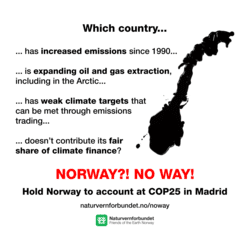Norway?! No way!
We Norwegians are proud of our country. But when it comes to successive governments since 1990, of the left or right, and their record on the climate emergency, there isn’t much to be proud of…

Did you know..?
- Norwegian emissions have increased since 1990.
- Norway’s petroleum industry is largely responsible for this increase, and oil and gas exports mean huge ‘exported emissions’ in other countries.
- Norway is planning further oil and gas expansion.
- Norway has weak climate targets that can be met with significant emissions trading.
- Norway does not have a plan for how to meet its climate targets.
- Norway’s contributions to climate finance are not in line with climate justice.
1. Norwegian emissions have increased since 1990.
On average, EU/EEA domestic greenhouse gas emissions have fallen over 23 per cent since 1990, while Norway’s nearest neighbours, Sweden and Denmark, have cut over 25 and 30 per cent respectively. In contrast, Norwegian emissions have increased just over 1 per cent since 1990. Worryingly, while other greenhouse gas emissions have fallen, carbon dioxide emissions in Norway have increased 24 per cent in the same period.
2. Norway’s petroleum industry is largely responsible for this increase, and oil and gas exports mean huge ‘exported emissions’ in other countries.
Emissions from Norwegian oil and gas, which is almost entirely exported to other countries, are nearly 10 times higher than the country’s domestic emissions. At the same time, domestic emissions from petroleum production have increased nearly 75 per cent since 1990.
3. Norway is planning further oil and gas expansion.
Despite the Paris Agreement’s goal of keeping global heating under 1.5 degrees, and the IPCC’s warnings that the world needs to halve its emissions by 2030, Norway is planning to increase oil and gas production towards a new peak in 2023. A report from Oil Change International shows that this is the fifth most aggressive plan for oil and gas expansion in the world betwen 2019 and 2024. This includes opening unexplored, vulnerable areas to petroleum extraction, especially the Arctic. This is why Norwegian environmental organisations are taking the government to court. The current Norwegian government set records for new oil and gas licenses in 2018 and 2019. The majority state-owned petroleum company, Equinor, is pushing forward with controversial plans for oil drilling around the world, including in the Great Australian Bight.
4. Norway has weak climate targets that can be met with significant emissions trading.
Norway is way off its goal of 30 per cent emissions reductions by 2020. The current climate target is 40 per cent reductions by 2030. Not only is this not enough, but the target does not say where these emissions cuts will take place; Norway can use emissions trading to meet its goals. This means we have no idea how high emissions in Norway will be in 2030 or in 2050, when Norway is supposed to be ‘climate neutral.’
5. Norway does not have a plan for how to meet its climate targets.
The Norwegian government will only make a start on its plan to cut emissions in line with its (inadequate) climate targets in 2020. Current projections suggest Norwegian emissions will fall just 12.5 per cent compared to 1990 by 2030 – nowhere near enough to reach Norwegian climate targets or Norway’s fair share of the Paris agreement (calculated at minimum 53 per cent emissions reductions before 2030 by Stockholm Environment Institute).
6. Norway’s contributions to climate finance are not in line with climate justice.
Though Norway has given comparatively high amounts to rainforest conservation and the Green Climate Fund (GCF), this is still far below its fair share of the Paris agreement. Only 8 per cent of Norwegian climate finance has gone to adaptation on average in recent years and least economically-developed countries (LEDCs) receive comparatively little of the country’s funding. Norwegian climate finance fell significantly after 2013. Despite recent increases back towards earlier levels of support, in the national budget for 2020, the government cut funding to renewable energy.
Help us to increase critical scrutiny of Norway from the international community and media:
- Use social media to tell Norway’s Prime Minister Erna Solberg, and Climate and Environment Minister Ola Elvestuen, that you expect Norway to increase its climate targets and climate finance, and make a plan for a just transition from oil and gas dependence.
- Share the picture above (dimensions for Instagram) in social media or this version with dimensions for Twitter.
- Send this page to journalists and anyone in your country that is interested when they cover Norway’s activities in Madrid.
- Get in touch with Friends of the Earth Norway if you want to know more.
Sources/more information
- Norwegian emissions, total and by sector: Statistics Norway.
- EU/EEA emissions: Eurostat.
- Exported emissions from Norwegian oil and gas: Sky’s the Limit: Norway by Oil Change International, 2017.
- Norwegian climate targets: Climate neutrality the Norwegian way: Carbon trading? by Erlend Andre Tveiten Hermansen and Bård Lahn, CICERO Centre for International Climate Research, 2019.
- What Norwegian climate targets should be from a climate justice perspective: Norway’s Fair Share of the Paris Agreement by Stockholm Environment Institute, 2018.
- Projections of Norwegian emissions: National Budget 2020 (in Norwegian).
- Norwegian climate finance for adaptation and LEDCs: Counting What Counts by the Forum for Development and Environment (ForUM), 2017; forthcoming research from Norwegian NGOs.